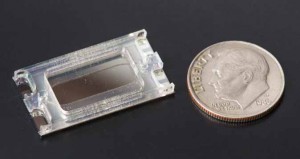Electric Chip Recovers Drug Nanoparticles from Blood

Researchers from the University of California, San Diego have discovered a new technique to isolate nanoparticles from blood plasma. An oscillating electric field can separate nanoparticles from complex liquids, allowing to recover, for example, drug-delivery particles. The finding could also have applications in industrial and environmental settings. The study has been published in the journal Small.
Drug-carrying nanoparticles can be used as therapeutic agents, introducing them in the blood. However, once they have done their function, the nanoparticles are usually recovered. This has proven difficult, due to the particles’ low density and small size. Several methods have been used: diluting the plasma, adding sugar and centrifuging the mix, or linking a targeting factor to the nanoparticle´s surface. All these methods have problems, because they modify the particle´s properties. Moreover, these methods can not be applied to some types of nanoparticle.
Looking for a better way to recover nanoparticles from plasma samples, the engineers from UCSD have developed a technique based on an electrokinetic platform. The technology takes advantage of the different dielectric properties of plasma and the nanoparticles. The device, developed by Biological Dynamics, is an electric chip that generates an oscillating electric field (purple lines in the picture) that draws the nanoparticles (yellow) towards electric rings that surround the chip’s electrodes. When the electric field is applied, the positive and negative charges inside the nanoparticles reorient themselves faster than the rest of charges in the plasma. In this way, the nanoparticles are directed towards the electrodes and leave the plasma molecules behind. Nanoparticle recovery is completed in 7 minutes, with minimal manipulation.
The researchers have validated their method with nanoparticles of different shape, density or material. The new separation system enables researchers to quickly recover the particles and analyze, by scanning electron microscopy, what modifications plasma molecules cause on their surface and general structure. This will allow to redesign the nanoparticles and make them more effective.
Source: UCSD



